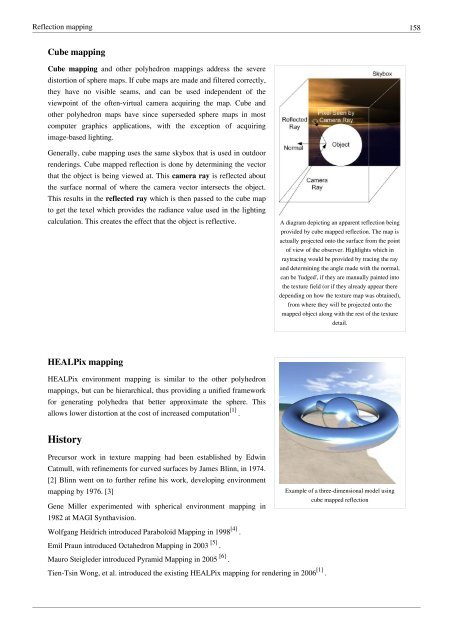3D graphics eBook - Course Materials Repository
3D graphics eBook - Course Materials Repository
3D graphics eBook - Course Materials Repository
You also want an ePaper? Increase the reach of your titles
YUMPU automatically turns print PDFs into web optimized ePapers that Google loves.
Reflection mapping 158<br />
Cube mapping<br />
Cube mapping and other polyhedron mappings address the severe<br />
distortion of sphere maps. If cube maps are made and filtered correctly,<br />
they have no visible seams, and can be used independent of the<br />
viewpoint of the often-virtual camera acquiring the map. Cube and<br />
other polyhedron maps have since superseded sphere maps in most<br />
computer <strong>graphics</strong> applications, with the exception of acquiring<br />
image-based lighting.<br />
Generally, cube mapping uses the same skybox that is used in outdoor<br />
renderings. Cube mapped reflection is done by determining the vector<br />
that the object is being viewed at. This camera ray is reflected about<br />
the surface normal of where the camera vector intersects the object.<br />
This results in the reflected ray which is then passed to the cube map<br />
to get the texel which provides the radiance value used in the lighting<br />
calculation. This creates the effect that the object is reflective.<br />
HEALPix mapping<br />
HEALPix environment mapping is similar to the other polyhedron<br />
mappings, but can be hierarchical, thus providing a unified framework<br />
for generating polyhedra that better approximate the sphere. This<br />
allows lower distortion at the cost of increased computation [1] .<br />
History<br />
Precursor work in texture mapping had been established by Edwin<br />
Catmull, with refinements for curved surfaces by James Blinn, in 1974.<br />
[2] Blinn went on to further refine his work, developing environment<br />
mapping by 1976. [3]<br />
Gene Miller experimented with spherical environment mapping in<br />
1982 at MAGI Synthavision.<br />
Wolfgang Heidrich introduced Paraboloid Mapping in 1998 [4] .<br />
Emil Praun introduced Octahedron Mapping in 2003 [5] .<br />
Mauro Steigleder introduced Pyramid Mapping in 2005 [6] .<br />
Tien-Tsin Wong, et al. introduced the existing HEALPix mapping for rendering in 2006 [1] .<br />
A diagram depicting an apparent reflection being<br />
provided by cube mapped reflection. The map is<br />
actually projected onto the surface from the point<br />
of view of the observer. Highlights which in<br />
raytracing would be provided by tracing the ray<br />
and determining the angle made with the normal,<br />
can be 'fudged', if they are manually painted into<br />
the texture field (or if they already appear there<br />
depending on how the texture map was obtained),<br />
from where they will be projected onto the<br />
mapped object along with the rest of the texture<br />
detail.<br />
Example of a three-dimensional model using<br />
cube mapped reflection
















